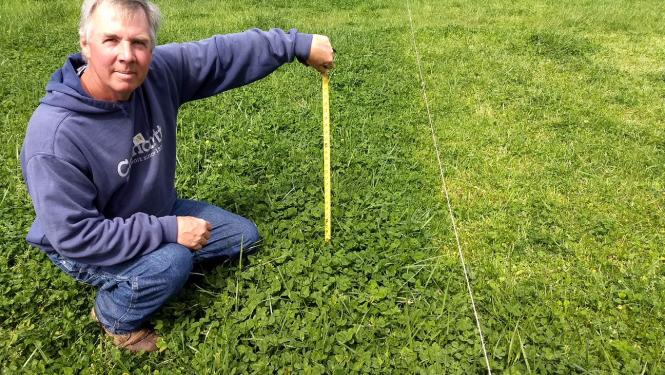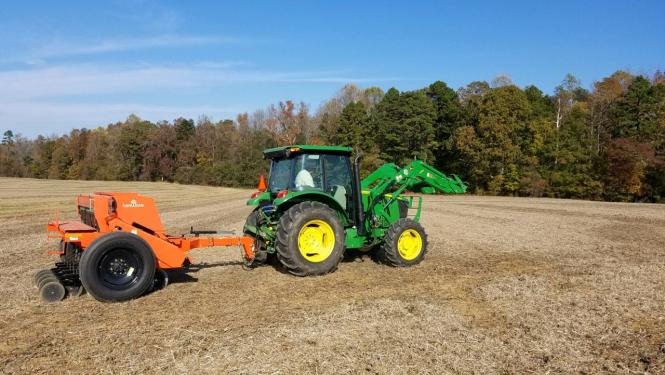I love diversity. I love polywire, strip grazing, and red clover. Ray’s Crazy Mix was my introduction to the idea of diversified forages and renovating the soil. I’ve seen what a difference can be made to forage quality by selecting a brown mid rib variety or using a photoperiod sensitive sorghum sudan. I don’t want to take anything away from the bells and whistles, or what I call, “top of the pyramid differences”. However, without the base principles in place, we are only spinning tires.&nb
It’s easy to focus on the “top of the pyramid” stuff. It’s fun to think that to fix our issues, we just need to plant 7 different species instead of 1. Yes, using mixtures compared to monocultures is better for pasture longevity, soil health, and helps you hedge your bets against nature. However, planting a mixture does not make you inherently successful. The bells and whistles can only be appreciated if the base is sound. Focus on getting the base correct, making those changes will make the biggest difference for you.
Rotationally Graze
You’ll see a lot of information that talks about doubling your stocking rate when you switch to rotational grazing; which is true, provided that you weren’t overstocked to start with. Most folks that I work with don’t get to change their stocking rate at all, but they dramatically reduce the amount of hay they have to feed. If your pastures are severely thinned from a history of overgrazing, don’t expect to rotationally graze your way out of the hay business. If the productive grasses are severely damaged or dead, it may take up to a year for you to rest or renovate that pasture back to health and productivity. This means a reduced stocking rate for a short period of time.
Plants don’t care about time. Your pastures don’t know if they were grazed for 24 hours or 48 hours. All they understand is their energy status, which is depleted by livestock by means of leaf removal. Don’t think that to rotationally graze well you have to practice mob or strip grazing! Watch the height of your plants. Observe their speed of recovery. As long as you respect the start and stop heights for your forages, you are doing great. You will see increased efficiency and utilization the more you tighten up your grazing window, but you can strip graze by moving livestock once a week or every 24 hours. Both are excellent and one is not inherently better than the other.
Soil Test and Act
“How should I fertilize this crop?” It’s an extremely common question that we get, and the reality is that we cannot accurately tell you without seeing a soil test. We can make some general assumptions, but especially if you are renovating pasture, that soil test is critical. To add to this, a soil test is only as good as the action taken as a result. This doesn’t necessarily have to be solved by commercial fertilizer either. There are many creative ways to improve the soil nutrients: concentrated winter hay feeding, compost or effluent waste, and poultry litter.
While soil samples can tell us a great deal about nutrient balance, there are a number of aspects of the soil that a commercial fertilizer can’t fix. There is work towards a commercial soil test to quantify soil health, like the Haney or Cornell soil tests, that we hope will do a better job qualifying the potential of the soil at that time to grow annual or perennial crops. When renovating a field, if it was overgrazed or significantly depleted in high yielding forages, there’s a reason why. Chances are there is something that has changed in the structure of the soil as a result of that management that deems it not ready for perennial forages. Be very active with your soils- dig, feel, and smell! Learn the physical soil differences between your fields. Take some time and change how you manage fields so that the soil may recover.

Get Off The Tractor and Farm
As specific as we like to be with seeding rates and depths, the reality is that when it comes down to getting things planted in the field, it’s all a little bit of guess work. There is no setting on the drill to keep it planting at 0.25” depth the whole pass through the field. There is no guarantee that your broadcast spreader is actually spreading 12 feet the entire time. To make sure you are getting as close to ideal as possible, it’s going to involve actively paying attention the whole time. As you pass through different soil types in the field, get off the tractor and check how that changed the depth the drill is using. Frequently stop and check that your broadcast spreader is not blocked and walk behind yourself to ensure that the seed is spreading evenly. Great farming is done before ever getting in the tractor seat.

You don’t have to plant a multispecies annual crop to build soil and you don’t have to rotate livestock every 12 or 24 hours to improve your soil and pasture health. The worst thing you can do is nothing, but don’t overcomplicate it. Utilize rotational grazing the best that you can with your schedule and limitations and take care of your soil. Livestock can be one of our greatest tools in improving the environment, we just have to get our bases right.